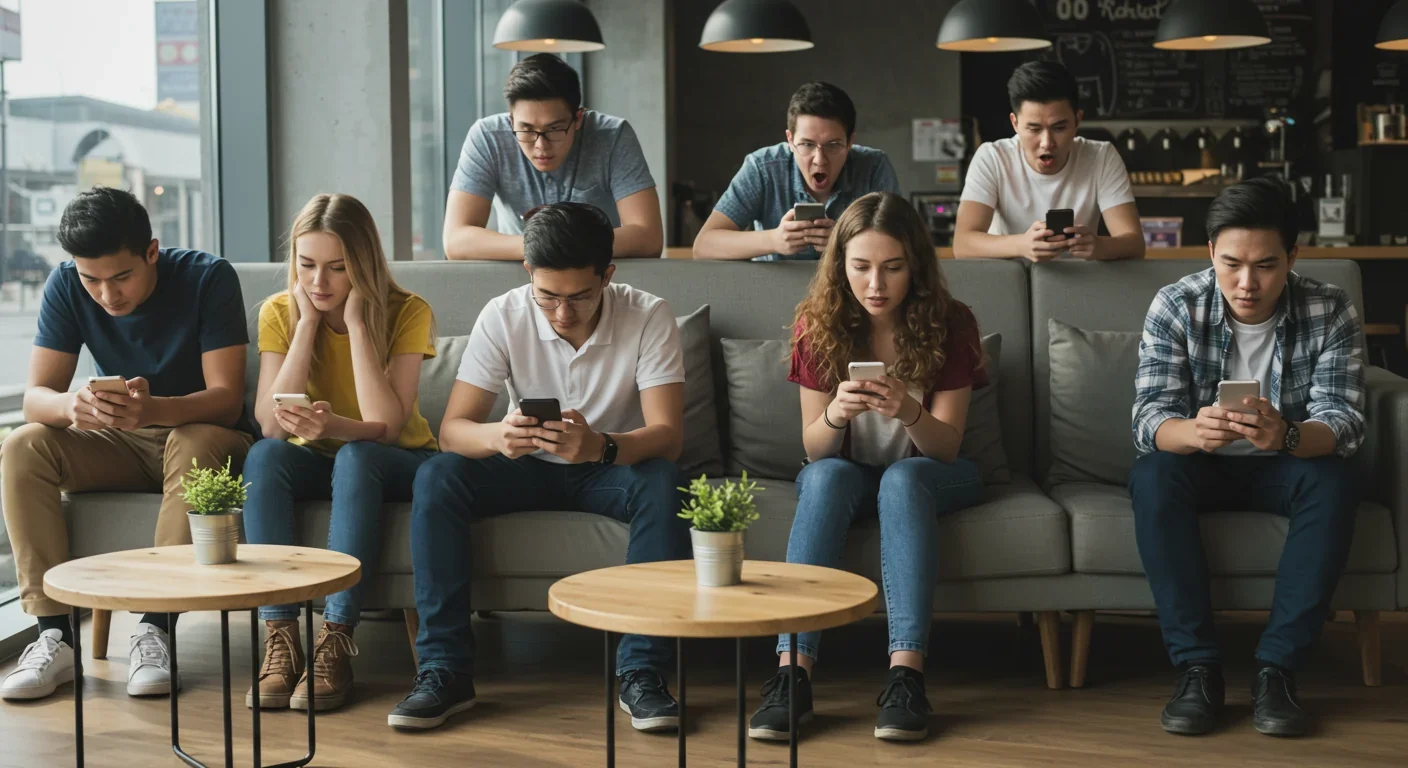Why Your Brain Sees Gods and Ghosts in Random Events

TL;DR: Cancel culture operates through predictable psychological mechanisms—moral outrage, group identity, and anonymity—amplified by platform algorithms. Understanding these forces can help us build more proportional accountability systems.

Right now, someone somewhere is being canceled. A tweet resurfaces, a video goes viral, and within hours thousands pile on with fury. The target becomes radioactive. Friends disappear. Employers distance themselves. Mental health spirals. Meanwhile, the rest of us scroll past, either joining the fray or feeling vaguely uneasy about the whole thing.
Cancel culture feels chaotic and unpredictable, but it's not. Behind every digital pile-on sits a surprisingly predictable set of psychological mechanisms that explain why ordinary people become online mobs. Understanding these forces won't make cancel culture disappear, but it might help us navigate a digital world where reputation can evaporate in minutes.
Humans are wired for moral judgment. We survived as a species because we could identify rule-breakers and punish them. In small tribes, that meant gossip and ostracism. In 2025, it means quote-tweeting with righteous fury.
When we witness a perceived transgression online, our brains light up with moral emotion. Research shows this isn't rational deliberation but an automatic gut reaction. We feel disgust, anger, or betrayal before we've consciously analyzed the situation. These emotions evolved to protect group cohesion, but on social media they trigger something different: a performance of virtue that others can witness and amplify.
That performance matters because cancel culture is fundamentally social. We don't cancel alone. We cancel as part of a group, and that group identity shapes everything. When you join a pile-on, you're signaling your values to your community. You're saying "I'm one of the good ones." The more you participate, the more you reinforce your belonging.
Social psychologists call this moral grandstanding. It's the impulse to use moral talk to impress others rather than to genuinely deliberate about right and wrong. Online platforms create perfect conditions for grandstanding because they maximize audience size while minimizing social risk. You can broadcast your righteousness to thousands without facing immediate pushback.
Social media doesn't just host cancel culture—it actively accelerates it. The architecture of these platforms is designed to maximize engagement, and outrage engages like nothing else.
Algorithms prioritize content that provokes strong emotional reactions. A nuanced take on a complicated issue gets buried. A screenshot of someone's worst moment goes viral. The algorithm doesn't care about context or fairness. It cares about clicks, shares, and time on platform.
This creates what researchers call an information cascade. Once a critical mass of people share something, others assume it must be important and share it too, often without reading beyond the headline. Within hours, a localized controversy becomes a global pile-on, not because everyone independently verified the facts, but because everyone saw everyone else sharing it.
Video content makes this worse. Studies show that video modality increases perceived realism and sharing intentions. When we see video of someone doing something offensive, we process it more superficially and believe it more readily. The realism heuristic kicks in—if something looks real, we assume it is real, even when context is missing or the video is selectively edited.
The problem compounds in echo chambers. Most of us curate our feeds to show content we agree with. Algorithms reinforce this tendency, creating digital bubbles where opposing views get filtered out. Inside these bubbles, cancel campaigns feel unanimous. Everyone you trust is saying the same thing, so it must be true. Dissent becomes unthinkable.
Anonymity adds fuel to the fire. When people can participate in a pile-on without attaching their real name, social inhibitions weaken. The normal checks on behavior—fear of judgment, concern for reputation, empathy for the target—fade away. Deindividuation takes over, and people say things they'd never say face to face.

For the targets, cancel culture isn't an abstract debate. It's a mental health crisis delivered at internet speed.
Research on cyberbullying shows links to anxiety, depression, and suicidal ideation. Being publicly shamed by thousands of strangers creates similar psychological damage. The experience is isolating and overwhelming. You watch your reputation disintegrate in real time while feeling powerless to stop it.
Self-esteem takes a massive hit. Studies reveal that cybervictimization significantly lowers self-esteem, which in turn mediates other mental health problems. When your identity is publicly attacked and you can't escape the barrage, your sense of self erodes. You internalize the shame. You start to believe maybe you deserve this.
The effects ripple outward. Canceled individuals often lose jobs, friendships, and opportunities. Some retreat from public life entirely. The punishment rarely fits the crime, and there's no clear path to rehabilitation. Cancel culture operates without due process or proportionality. One mistake can result in permanent social exile.
Even observers feel the impact. Witnessing cancel campaigns creates a chilling effect on speech and creativity. People self-censor, afraid their words might be misinterpreted or weaponized. Academic discourse suffers. Artistic experimentation withers. The marketplace of ideas shrinks because the cost of being wrong is too high.
Cancel culture didn't emerge from nowhere. Its roots stretch back to earlier forms of social accountability, from consumer boycotts to public call-outs in activist communities.
The term itself gained traction in Black Twitter communities around 2014-2015, initially as a way for marginalized groups to hold powerful people accountable. Early cancel campaigns targeted celebrities and public figures who'd made racist, sexist, or homophobic comments. The logic was simple: if institutions won't hold these people accountable, we will.
For a while, this grassroots version of cancel culture functioned as a kind of distributed justice system. People with minimal institutional power could band together and impose reputational costs on the powerful. Brands started listening. Public figures started apologizing. It felt like progress.
But as cancel culture moved mainstream, it changed. What started as punching up became punching in every direction. The same tactics used against powerful celebrities got deployed against ordinary people, often for minor infractions. The tools of accountability became tools of mob justice.
Mainstream media amplified this shift. Every cancel campaign became a story, which meant more visibility and more participants. Traditional journalists, trained to seek balance, often framed cancel culture as a binary debate: defenders of accountability versus defenders of free speech. This framing missed the complexity. Most people occupy a middle ground, supporting accountability while worrying about proportionality and due process.
By 2020, "cancel culture" had become a political football. Conservatives used it to dismiss legitimate criticism. Progressives denied its existence or defended it as necessary resistance. The debate became so polarized that nuanced discussion became nearly impossible. Meanwhile, the underlying dynamics—moral outrage, algorithmic amplification, mob behavior—continued unabated.
Cancel culture reshapes more than individual lives. It's changing how we talk, create, and govern.
Democratic discourse depends on the ability to argue, change minds, and forgive mistakes. Cancel culture undermines all three. When any statement can be career-ending, people stop engaging across difference. They retreat into ideological safe spaces where they only encounter agreement. Political polarization deepens.
Creative industries feel the squeeze. Writers, comedians, and artists report increasing anxiety about pushing boundaries or taking risks. The fear of cancellation leads to safer, blander work. Cultural innovation requires the freedom to fail, but cancel culture makes failure existentially dangerous.
Institutions struggle to respond. Universities cancel speakers to avoid controversy. Publishers reject manuscripts deemed too risky. Companies fire employees at the first whiff of scandal, less concerned with justice than with brand protection. Crisis communications in the cancel culture era has become its own industry, helping organizations navigate the reputational minefield.
The legal system can't keep up. Defamation law was written for a pre-internet age. It doesn't account for coordinated online campaigns or algorithmic amplification. Victims of unjust cancellations have few legal remedies. Meanwhile, actual defamation thrives because proving damages in the attention economy is nearly impossible.
Perhaps most troubling is the erosion of proportionality. In traditional justice systems, punishment scales with offense. In cancel culture, everything gets maximum punishment. A thoughtless joke from a decade ago receives the same treatment as a pattern of serious misconduct. Without gradations of consequence, there's no incentive to distinguish between minor and major transgressions.

Cancel culture isn't uniquely American, but it manifests differently across cultures.
In East Asian countries, public shaming has deep cultural roots. Societies that emphasize collective harmony over individual expression have long used social pressure to enforce conformity. Digital platforms amplify these existing dynamics. In China, social credit systems formalize what cancel culture does informally: creating permanent reputational scores based on behavior.
European approaches tend toward more formal regulation. The European Union's Digital Services Act requires platforms to address harmful content and algorithmic transparency. Germany's NetzDG law mandates swift removal of illegal content, though critics worry it encourages over-censorship.
Latin American countries face unique challenges. High levels of violence against journalists and activists mean cancel campaigns can escalate to physical threats. The stakes are different when online shaming can lead to offline harm. Activists in these regions report carefully weighing whether calling someone out is worth the potential danger.
In Africa, limited internet penetration means cancel culture remains largely urban and elite. But that's changing fast as smartphone adoption spreads. Countries are grappling with how to foster accountability while protecting free expression, often without the institutional frameworks wealthier nations take for granted.
Middle Eastern contexts add religious and political complexity. Governments use cancel-culture tactics to suppress dissent, labeling criticism as blasphemy or national betrayal. Citizens walk a tightrope, trying to hold power accountable while avoiding retaliation. The line between grassroots accountability and state repression blurs.
Understanding the psychology behind cancel culture suggests concrete strategies for healthier digital behavior.
Pause before piling on. When you encounter something outrage-inducing, sit with it for an hour before sharing. Ask yourself: Do I have the full context? Is my emotional reaction proportional to the offense? Am I sharing this to inform or to signal?
Check your sources. Information cascades spread falsehoods as easily as truth. Before joining a cancel campaign, verify the facts independently. Read beyond headlines. Seek out perspectives that complicate the narrative. Be especially skeptical of decontextualized video clips.
Consider proportionality. Not every mistake deserves maximum punishment. Ask whether the proposed consequences fit the offense. Is permanent exile appropriate, or would a public apology and learning opportunity be better?
Embrace complexity. Most situations contain shades of gray. Someone can do something harmful without being irredeemable. Behavior can be criticized without the person being canceled. Resist the binary thinking that platforms encourage.
Practice digital empathy. Remember there's a human on the receiving end of your outrage. Would you want to be defined forever by your worst moment? Anonymity weakens empathy, so consciously cultivate it.
Support restorative approaches. Some organizations are experimenting with restorative justice models that prioritize repair over punishment. These approaches focus on understanding harm, making amends, and preventing recurrence rather than permanent exile.
Institutions have a role to play in creating healthier accountability mechanisms.
Platforms should redesign engagement incentives. What if algorithms promoted thoughtful discussion instead of outrage? What if sharing required reading the article first? What if context warnings appeared on decontextualized clips?
Media organizations need better standards for covering cancel campaigns. Not every pile-on deserves amplification. Journalists should verify claims, include context, and avoid sensationalizing. The goal should be informing the public, not feeding the outrage machine.
Employers should implement due process before terminating employees over online controversies. Investigate claims independently. Consider intent, context, and proportionality. Create pathways for accountability and rehabilitation instead of instant termination.
Educational institutions should teach digital literacy and media criticism. Students need to understand how algorithms shape what they see, how to evaluate sources, and how to engage constructively across difference. These skills are as essential as reading and writing.
Crisis communications professionals increasingly advise clients to respond quickly, authentically, and proportionally. Hiding makes it worse. So does insincere apologizing. The key is acknowledging harm, explaining context, and committing to specific changes.
Cancel culture isn't going away, but it might evolve.
Some observers note emerging patterns of "reverse cancel culture" where brands or individuals deliberately court controversy to attract loyal supporters. The calculus is shifting: for some, being canceled by one group means being embraced by another.
We're also seeing more pushback against disproportionate pile-ons. Public figures increasingly refuse to apologize for minor infractions, betting that the outrage cycle will move on quickly. Sometimes it works. The effectiveness of cancel campaigns may be waning as fatigue sets in.
Technology might offer solutions. Reputation systems that allow for rehabilitation. Algorithmic changes that slow viral spread. Tools that provide context before allowing shares. Platforms that reward constructive engagement over performative outrage.
But technology alone won't solve what is fundamentally a human problem. Cancel culture thrives because it satisfies deep psychological needs: belonging, status, moral clarity in an ambiguous world. Addressing it requires cultural change as much as technical fixes.
The question isn't whether to hold people accountable but how to do it wisely. Can we create systems that allow for genuine learning and growth? Can we build digital spaces that encourage empathy alongside accountability? Can we develop the psychological resilience to tolerate complexity instead of demanding perfect moral purity?
The psychology behind cancel culture reveals both our capacity for collective action and our vulnerability to mob dynamics. Understanding these forces gives us a choice: we can let the worst aspects of human psychology dominate our digital spaces, or we can deliberately cultivate better norms.
The internet amplifies everything—both our best and worst impulses. Cancel culture demonstrates how quickly righteous accountability can curdle into cruel mob justice. But the same platforms that enable pile-ons could foster genuine dialogue, restorative justice, and proportional accountability. We built this system. We can rebuild it differently.
The next time you encounter something outrage-inducing online, you'll have a choice. You can ride the emotional wave and pile on, joining thousands in ritual denunciation. Or you can pause, check your psychology, verify the facts, and ask whether your participation serves justice or just feels good. That moment of choice, multiplied across millions of users, determines whether we get the internet we want or the one our worst impulses create.

Recent breakthroughs in fusion technology—including 351,000-gauss magnetic fields, AI-driven plasma diagnostics, and net energy gain at the National Ignition Facility—are transforming fusion propulsion from science fiction to engineering frontier. Scientists now have a realistic pathway to accelerate spacecraft to 10% of light speed, enabling a 43-year journey to Alpha Centauri. While challenges remain in miniaturization, neutron management, and sustained operation, the physics barriers have ...

Epigenetic clocks measure DNA methylation patterns to calculate biological age, which predicts disease risk up to 30 years before symptoms appear. Landmark studies show that accelerated epigenetic aging forecasts cardiovascular disease, diabetes, and neurodegeneration with remarkable accuracy. Lifestyle interventions—Mediterranean diet, structured exercise, quality sleep, stress management—can measurably reverse biological aging, reducing epigenetic age by 1-2 years within months. Commercial ...

Data centers consumed 415 terawatt-hours of electricity in 2024 and will nearly double that by 2030, driven by AI's insatiable energy appetite. Despite tech giants' renewable pledges, actual emissions are up to 662% higher than reported due to accounting loopholes. A digital pollution tax—similar to Europe's carbon border tariff—could finally force the industry to invest in efficiency technologies like liquid cooling, waste heat recovery, and time-matched renewable power, transforming volunta...

Humans are hardwired to see invisible agents—gods, ghosts, conspiracies—thanks to the Hyperactive Agency Detection Device (HADD), an evolutionary survival mechanism that favored false alarms over fatal misses. This cognitive bias, rooted in brain regions like the temporoparietal junction and medial prefrontal cortex, generates religious beliefs, animistic worldviews, and conspiracy theories across all cultures. Understanding HADD doesn't eliminate belief, but it helps us recognize when our pa...

The bombardier beetle has perfected a chemical defense system that human engineers are still trying to replicate: a two-chamber micro-combustion engine that mixes hydroquinone and hydrogen peroxide to create explosive 100°C sprays at up to 500 pulses per second, aimed with 270-degree precision. This tiny insect's biochemical marvel is inspiring revolutionary technologies in aerospace propulsion, pharmaceutical delivery, and fire suppression. By 2030, beetle-inspired systems could position sat...

The U.S. faces a catastrophic care worker shortage driven by poverty-level wages, overwhelming burnout, and systemic undervaluation. With 99% of nursing homes hiring and 9.7 million openings projected by 2034, the crisis threatens patient safety, family stability, and economic productivity. Evidence-based solutions—wage reforms, streamlined training, technology integration, and policy enforcement—exist and work, but require sustained political will and cultural recognition that caregiving is ...

Every major AI model was trained on copyrighted text scraped without permission, triggering billion-dollar lawsuits and forcing a reckoning between innovation and creator rights. The future depends on finding balance between transformative AI development and fair compensation for the people whose work fuels it.